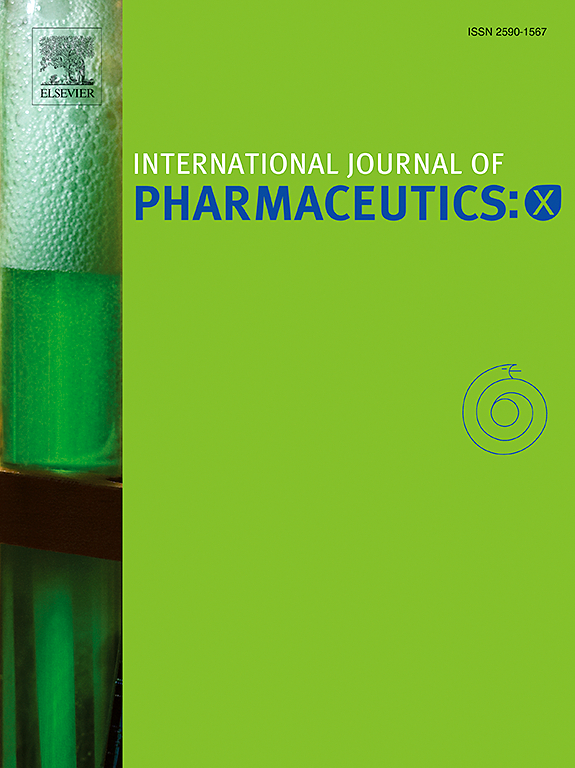协同光动力和化学动力治疗使用低氧适应性Ce6@Co纳米颗粒增强肿瘤抑制
IF 6.4
2区 医学
Q1 PHARMACOLOGY & PHARMACY
引用次数: 0
摘要
传统的光动力治疗(PDT)在实体肿瘤中效果较差,因为ii型PDT机制依赖于氧气(O2),而氧气在缺氧环境中是稀缺的。大多数疏水光敏剂具有较差的水溶性,使其配方和输送复杂化。为了解决这些挑战,Ce6@Co纳米颗粒(一种低氧适应纳米平台)通过配合Co2+离子与氯e6 (Ce6)开发,具有均匀的尺寸(~ 230 nm),增强的分散性和胶体稳定性。这些纳米粒子产生双模式活性氧(ROS):在670 nm照射下通过PDT产生ii型1O2,通过Co2+介导的芬顿样反应产生氧不依赖型羟基自由基(⋅OH)。在体外,Ce6@Co纳米颗粒表现出优越的细胞摄取和强大的ROS扩增能力,通过协同光动力学和化学动力学(PDT-CDT)效应,将鳞状细胞癌(SCC7)细胞活力在常氧条件下降低至34.4%,在缺氧条件下降低至20.48%,导致大量凋亡。在体内,通过激光照射给药Ce6@Co纳米颗粒可完全抑制SCC7荷瘤小鼠的肿瘤。这种效果归因于有利的肿瘤内分布、增强的保留和协同的PDT-CDT。体重稳定,血清生物标志物正常,器官组织学不变,未观察到全身毒性。Co2+协同光敏剂系统利用缺氧升高的H2O2维持CDT,有效克服了传统PDT对氧的依赖,为缺氧实体瘤提供了安全有效的双峰治疗策略。本文章由计算机程序翻译,如有差异,请以英文原文为准。
Synergistic photodynamic and chemodynamic therapy using hypoxia-adaptive Ce6@Co nanoparticles for enhanced tumor suppression
Conventional photodynamic therapy (PDT) is less effective in solid tumors owing to Type-II PDT mechanism's reliance on oxygen (O2), which is scarce in hypoxic environments. Most hydrophobic photosensitizers have poor water solubility, complicating their formulation and delivery. To address these challenges, Ce6@Co nanoparticles (a hypoxia-adaptive nanoplatform) were developed via coordinating Co2+ ions with chlorin e6 (Ce6), exhibiting uniform size (∼230 nm), enhanced dispersibility, and colloidal stability. These nanoparticles generate dual-mode reactive oxygen species (ROS): Type-II 1O2 via PDT under 670 nm irradiation and oxygen-independent hydroxyl radical (⋅OH) via Co2+-mediated Fenton-like reactions. In vitro, Ce6@Co nanoparticles demonstrated superior cellular uptake and robust ROS amplification, and reduced squamous cell carcinoma (SCC7) cell viability to 34.4 % under normoxia and 20.48 % under hypoxia via synergistic photodynamic and chemodynamic (PDT-CDT) effects, causing considerable apoptosis. In vivo, intratumoral administration of Ce6@Co nanoparticles via laser irradiation completely suppressed tumors in SCC7 tumor-bearing mice. This effect was attributed to favorable intratumoral distribution, enhanced retention, and synergistic PDT-CDT. No systemic toxicity was observed, as indicated by stable body weight, normal serum biomarkers, and unchanged organ histology. The Co2+-coordinated photosensitizer system uses hypoxia-elevated H2O2 to sustain CDT, effectively overcoming conventional PDT's oxygen dependence and offering a safe and effective dual-modal therapeutic strategy for hypoxic solid tumors.
求助全文
通过发布文献求助,成功后即可免费获取论文全文。
去求助
来源期刊

International Journal of Pharmaceutics: X
Pharmacology, Toxicology and Pharmaceutics-Pharmaceutical Science
CiteScore
6.60
自引率
0.00%
发文量
32
审稿时长
24 days
期刊介绍:
International Journal of Pharmaceutics: X offers authors with high-quality research who want to publish in a gold open access journal the opportunity to make their work immediately, permanently, and freely accessible.
International Journal of Pharmaceutics: X authors will pay an article publishing charge (APC), have a choice of license options, and retain copyright. Please check the APC here. The journal is indexed in SCOPUS, PUBMED, PMC and DOAJ.
The International Journal of Pharmaceutics is the second most cited journal in the "Pharmacy & Pharmacology" category out of 358 journals, being the true home for pharmaceutical scientists concerned with the physical, chemical and biological properties of devices and delivery systems for drugs, vaccines and biologicals, including their design, manufacture and evaluation. This includes evaluation of the properties of drugs, excipients such as surfactants and polymers and novel materials. The journal has special sections on pharmaceutical nanotechnology and personalized medicines, and publishes research papers, reviews, commentaries and letters to the editor as well as special issues.
 求助内容:
求助内容: 应助结果提醒方式:
应助结果提醒方式:


